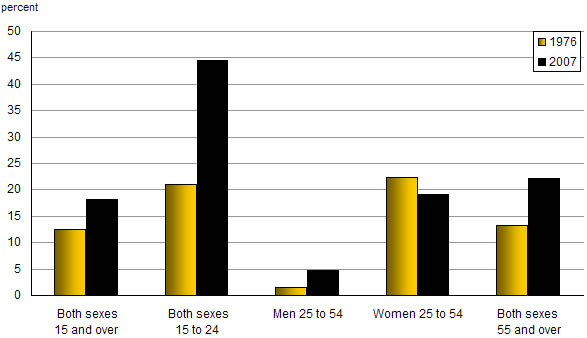Publications
The Canadian Labour Market at a Glance
Part-time employment rates
Archived Content
Information identified as archived is provided for reference, research or recordkeeping purposes. It is not subject to the Government of Canada Web Standards and has not been altered or updated since it was archived. Please "contact us" to request a format other than those available.
Part-time rates highest among youth
-
A number of factors are thought to be behind the long-term increase in part-time work: the switch to a service-based economy, extended operating and production schedules, and increased fluctuations in business activities. Also, both employers and employees have more widely accepted flexible hours—as a cost-saving measure for employers and as a means of balancing home and work lives for employees.
-
Part-time employment rates have increased most notably among youth: more than two in five 15- to-24-year-olds worked part time in 2007, compared with only one in five in 1976. With more young people attending school, working part time may be the most feasible option for those who want to earn money and gain work experience.
-
Part-time work was also common among women aged 25 to 54 and workers 55 and over. About one in five workers in these two groups worked part time in 2007, while few adult men (4.6%) did so. The part-time rate has grown for older workers and 25- to-54-year-old men since 1976, while it has dropped slightly for women of the same age.Youth were more likely to work part time in retail trade, food services, and information, culture and recreation. Women aged 25 to 54 and older workers were more likely to work part time in health care and social assistance, retail trade or educational services.
Chart G.2
Part-time employment rates, by sex and age,
1976 and 2007

Source: Statistics Canada, Labour Force Survey, CANSIM table 282-0002.
- Date modified:
